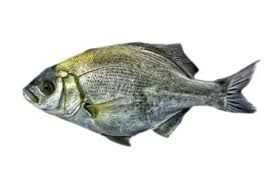Rubberlip Seaperch

Species Details
Rhacochilus Toxotes
Embiotocidae
Perciformes
onshore, nearshore, jetties, piers
2 - 5 lbs.
8" - 18"
Rubberlip Seaperch (Rhacochilus toxotes) Fish Description
The Rubberlip Seaperch (Rhacochilus toxotes) is popular gamefish mostly targeted for its meaty body. It can easily be recognized through its plump and compressed oval-shaped body and its dark deeply forked tail. It has a brown to brassy coloration that has a darker hue on the topside, gradually turning to light tan on the sides and belly. It also has distinctive dark lateral lines on both sides that run from the gills to the caudal fin. Another way to tell it apart from other fish species is through its large and thick prominent lips that are colored dirty white or faint pink, which kind of look like rubber, which is where it actually got its name.
The Rubberlip Seaperch is a viviparous fish that gives birth to live ones. The fish often mates during the summer when the algal growth is denser in the kelp forest. This is where they give birth and where the young usually stay for protection from predators and where they get their sustenance.
Diet and Size
The Rubberlip Seaperch is a demersal carnivorous fish. This means that it usually stays on or near the seabed to hunt for food of mainly benthic organisms, including small shrimp, amphipods, crabs, or mollusks.
As the largest of the seaperch family, the Rubberlip Seaperch can grow as much as eighteen and a half inches in length and can weigh as much as five pounds. Most that are caught, however, are less than thirteen inches long.
Rubberlip Seaperch Interesting Facts
- The Rubberlip Seaperch is the largest of the Sabastidae or seaperch family.
- The biggest Rubberlip Seaperch caught measures eighteen and a half inches long and weighs five pounds.
- The record fish was caught off Monterey Bay in 2009.
- Their average lifespan tends to be between seven to ten years.
- Juveniles usually have one or two vertical dusky bars on the body, but tend to disappear when they reach adulthood.
- They are often found schooling with Pile Perch.
- They use their protruding lips to “taste” their surroundings and detect their prey.
- They are mostly targeted by anglers because they contain quite a bit of meat as compared to other seaperch.
- Although they’re meaty, their flesh is said to have a very mild taste.
- It is said that the best way to cook its meat is by frying it in butter with some mild aromatics like dill, rosemary, or thyme.
Fishing Tips
The Rubberlip Seaperch can easily be caught off jetties and piers, or even along the shore; although you can also catch them on a boat when you’re fishing in Monterey Bay or San Francisco Bay. Best baits to use include fresh mussels, live sea worms, small pieces of shrimps, or any other similar options. You can pretty much use any type of gear to catch this fish, but make sure to use a small hook of either 4 or 6 to be able to hook this fish firmly on its small mouth.
Habitat and Distribution
Rubberlip Seaperch prefers the shallow parts of coastal waters, often within less than 160 feet in depth. They usually stay near or within kelp forests, rocky seabed, and sometimes in estuaries and bays. They are also commonly caught off piers and jetties.
The Rubberlip Seaperch is endemic in the Eastern Pacific, mainly within the coastal waters of California—as far north as the Mendocino County to central Baja California in Mexico. They are, said to be most abundant around San Francisco Bay and the Monterey Bay area, which is where the world record was caught.







